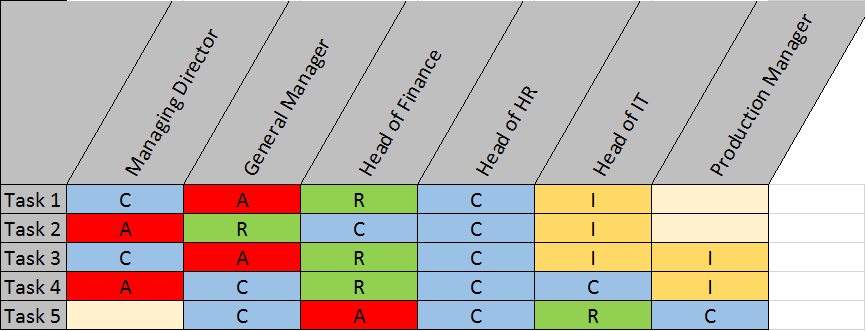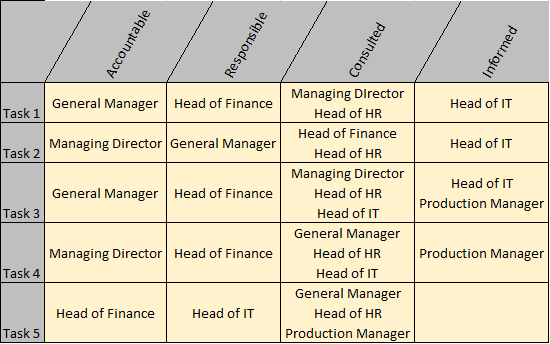I was discussing the question of responsibility and accountability with one of my clients recently and they were having difficulty distinguishing the two. This was one of the contributory factors why many of the strategies and projects they initiated failed to achieve the outcomes expected. So what is the difference between being responsible for something in your business and being accountable?
In simple terms, responsibility may be bestowed, but accountability must always be taken. Or to put it another way responsibility can be given or received, even assumed, but that doesn’t automatically mean that personal accountability will be taken. Which means that it’s possible for someone to have responsibility for something but lack the accountability.
This is critically important, not just in project management, but in everything you do in your business. The problem is that this generally only comes to light when something goes wrong!
Take the following short story as a light hearted way of describing the issue:
“This is a story of four people named Everybody, Somebody, Anybody, and Nobody. There was an important job to be done and Everybody was asked to do it. Everybody was sure Somebody would do it. Anybody could have done it, but Nobody did it. Somebody got angry about that because it was Everybody’s job. Everybody thought Anybody could do it, but Nobody realized that Everybody wouldn’t do it. It ended that Everybody blamed Somebody when Nobody did what Anybody could have done.”
We have probably all witnessed events like this, but how can we prevent this happening?
Clear communication is obviously important, particularly when delegating tasks to others i.e. giving someone else responsibility for a task that you are accountable for delivering. Always make sure the other person is fully aware that they are responsible and, where possible, use SMART (see below) as a guideline for setting objectives.
SMART Objectives
S = Specific. Because woolly objectives only lead to confusion
M = Measurable. It must be possible to measure when the task is complete, or to track progress towards the goal
A = Achievable. Do not set goals or objectives that are unachievable within the given parameters.
R = Realistic. Make sure the bar is at the right height. Too low can be as demotivating as one too high.
T = Timely. Frame the task with a time frame to ensure a sense of urgency.
Another way of ensuring that accountability and responsibility are set is to use the RACI Matrix. The RACI matrix is a very useful tool in project management used for tracking roles and responsibilities. RACI is an acronym for:
Responsible – Who is responsible for the execution of the task?
Who will be doing the work?
Accountable – Who is accountable for the tasks and signs off the work?
Who will take decisions and who’s head will roll if it goes wrong?
Consulted – Who are the people who need to be consulted during the task?
This implies two-way communication
Informed – Who are the people who need to be updated of the progress?
Who’s work depends on this task?
To use the RACI Matrix construct a grid with all the stakeholders along the top and the tasks or actions down the side. For each grid identify who is Accountable and Responsible and who needs to be Consulted or Informed.

You may also want to draw the grid with the RACI roles along the top. This ensures that you have all roles covered.

Top Tips for using RACI
- Make sure that every task has the roles of Responsible and Accountable identified.
- For a simple task the same person can be Accountable and Responsible.
- Accountability can only rest with one person. If more than one person is assigned as accountable it leads to confusion (see the short story above!)
- Similarly for the Responsible role avoid more than 2 people because this can lead to duplication of work.
- Avoid using groups of people instead of individual roles or named people. A body, such as a management team, cannot be accountable when it comes to actionable tasks or activities.
- Communicate to all stakeholders to ensure everyone understands their role.
Going back to my client I mentioned at the top of this post, they have used the RACI Matrix to ensure that all of their strategic initiatives and associated business projects are assigned to the right people in the organisation. This has been done as part of the implementation of a PMO and the introduction of project portfolio management – more about this in a future post.
If you found this post useful or interesting, you might like to subscribe to my regular updates using the form on the right hand side of the page. A mention on your favourite social media site would also be appreciated. Thank you.






9 responses
I have been using RACI for a while and have found it excellent to define processes, position descriptions, and training requirements.
When I was first taught RACI Accountable was explained as “the position that defines how the task is to be performed”. In this way it pushes the accountability down to the lowest level.
For Responsible I often get push back about having a single position Responsible (completing the task). If there are multiple positions that appear to be Responsible then that this indicates that the task can be further divided into multiple sub tasks. For example you may have the mechanic and auto electrician responsible for a task when it can be further divided into the mechanical tasks and also the electrical tasks.
Cheers
Hi Martin, thanks for adding a comment, much appreciated.
I agree with you about breaking tasks down if there are too many people responsible. This also can help with assigning accountability.
All the best
Paul
Hi There, This is such an engaging website with an easygoing and pleasing layout and look and feel.
I’ve enjoyed reading your articles and found several that have helped me clarify my own understanding of terms, concepts and the practical application thereof.
Thank you and regards
Ash
A detailed action plan with fixed time frame work , and allocated budget , gives us positive results during our research and development stage
For commercialization
( R A C I ) matrix should be adopted .
As our project rests upon sustainable and affordable housing we should work collectively for preparing a concrete idea about
CODE OF BUILDING .
Consequently ( C R M)
Customer Relationships Management , should be considered .
Best regards .
RACI seems to be a system enforcing management of individuals through hierarchy and discourages teamwork. Does the single individual accountable rule mean that RACI is incompatible with real teams who have shared accountability as a team and accountability to each other within the team?
Also, is RACI impractical for teams with dynamic responsibility taking at a fine-grained task level that varies frequently e.g. daily?
Hi Rowan, thank you for taking the time to comment. Your points are both interesting and insightful.
In my view, as with all management tools experience is needed to use the right tool in the right situation. I do believe RACI is useful for defining high level accountabilities and responsibilities but as you rightly pointed out it won’t work in a dynamic environment and it also won’t work well when used at a fine grained level. In my experience, in the environments you describe if you move up a level it will still be possible to broadly define who is accountable and responsible for an area or category of task/responsibility even if the individual sub-tasks and detail is more dynamic.
I also get the point about shared accountability and this can work well, but the problem comes when things go wrong. Depending on the relationships within the team and any commercial or contractual arrangements this has the potential to at best muddy the waters and at worst lead to litigation if accountabilities are not accurately defined.
Kind regards
Paul